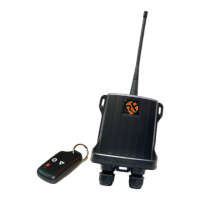Low Battery Indication
Low Battery IndicationLow Battery Indication
Low Battery Indication
When the battery on the HORNET-TX becomes low (<2.1V) the LED will indicate this by pulsing on and
off and one second intervals. The battery should be changed at this point. When the battery reaches
this level the HORNET-TX may continue to operate but the range will be reduced and the LED will dim.
Technical Specifications
Technical SpecificationsTechnical Specifications
Technical Specifications
Transmitters: HORNET
Transmitters: HORNETTransmitters: HORNET
Transmitters: HORNET
Enclosure Rating: Standard (TBA)
(TBA) (TBA)
(TBA) With IP Kit IP65
IP65 IP65
IP65
Battery Type: CR2032
CR2032CR2032
CR2032 Revision 2 - Post May 2010 GP23AE
GP23AE GP23AE
GP23AE (Revision 1 - Pre May 2010)
Battery Life Est. 3 Years (Calculated as 50 operations per day)
Dimensions: 66 x 36 x 17mm
Changing Batteries: Remove Two fixing screws, remove battery and replace, note polarity!
Transmitter FCC Notice
Transmitter FCC NoticeTransmitter FCC Notice
Transmitter FCC Notice
This device complies with part 15 of the FCC rules.
Operation is subject to the following two conditions.
• This device may not cause harmful interference AND
•
•
This device must accept any interference received including interference that may cause undesirable
operation.
Warning to user
Warning to userWarning to user
Warning to user
Changes or modifications not expressly approved by the party responsible for compliance could void the
user’s authority to operate the equipment.
Electrical Characteristics
Electrical CharacteristicsElectrical Characteristics
Electrical Characteristics
Min
MinMin
Min
Typical
TypicalTypical
Typical
Max
MaxMax
Max
Units
UnitsUnits
Units
Supply Voltage (Rev1)
3 (12)
V
Supply Current (transmitting)
0.47 (16)
uA (mA)
Frequency:
432.90
433.920
434.10
MHz
RF Output Power (ERP) @ 433 MHz
-
3
mW
Packet length 68 ms
FCC NOTE
FCC NOTEFCC NOTE
FCC NOTE
This equipment has been tested and found to comply with the limits for a Class B digital device, pursuant
to part 15 of the FCC Rules. These limits are designed to provide
reasonable protection against harmful interference in a residential installation.
This equipment generates, uses and can radiate radio frequency energy and, if not installed and used in
accordance with the instructions, may cause harmful interference to radio
communications. However, there is no guarantee that interference will not occur in a particular installa-
tion. If this equipment does cause harmful interference to radio or television
reception, which can be determined by turning the equipment off and on, the user is encouraged to try to
correct the interference by one or more of the following measures:
—Reorient or relocate the receiving antenna.
—Increase the separation between the equipment and receiver.
—Connect the equipment into an outlet on a circuit different from that to which the receiver is con-
nected.
—Consult the dealer or an experienced radio/TV technician for help.

